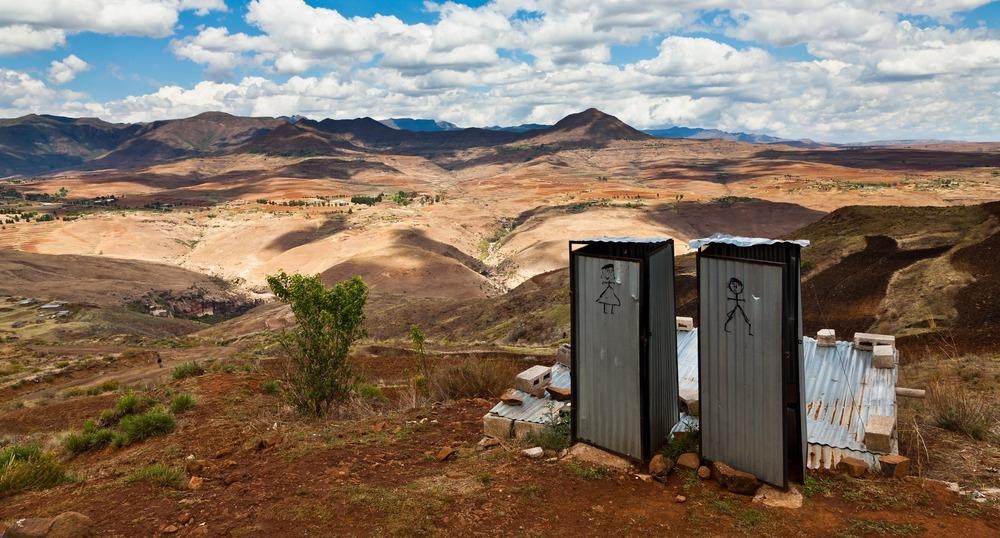A waterless toilet system from Loowatt seeks to address the global sanitation crisis while facilitating the creation of energy-from-waste to enhance access to renewable energy sources in local communities.

Around one in three people do not have access to a toilet. In addition, a lack of safe sanitation results in three-quarters of a million deaths each year. Image Credit: Peter Wollinga/Shutterstock.com
Tackling the Sanitation Crisis
Around half of the world’s population does not have access to safe sanitation and around one in three people have no access to a toilet, instead of spending hours each day searching for a safe place to go, with one in ten being forced to defecate in the open. Shockingly, more people have a mobile phone than a toilet.
In some countries, the sanitation crisis is more pronounced, and incredibly high levels of the population are living without toilets: 75% in Uganda, 67% in Ghana, 66% in Ethiopia, 58% in Kenya, and 53% in Bangladesh.
This lack of access to safe sanitation results in more than three-quarters of a million unnecessary deaths each year, with children, the vulnerable, and the elderly being at particular risk. Statistics show that every two minutes, a child younger than five dies from diseases due to poor water and sanitation.
It is important to help communities access clean water and toilets so they can keep themselves and their surroundings clean, prevent the spread of disease, and live with dignity. However, the solution to the sanitation crisis is more complicated than providing at-risk communities with domestic toilets. Often, these empty out into fresh waterways and land, resulting in contamination of the environment and spreading disease. Over 60% of untreated waste from toilets flows out into the environment.
To tackle the sanitation crisis, traditional, sewered toilets hinder the problem as they contribute to the spread of disease and rely on vast quantities of water, a resource that is often limited in areas subject to sanitation issues. Water stress continues to rise, with estimations that by 2030, half of the world will live in water-stressed areas.
London-based Loowatt is offering a solution to the sanitation crisis with its waterless toilet system.
Loowatt Toilets - Tana, Madagascar 2019 - World Toilet Day
Video Credit: Loowat Ltd./YouTube.com
What is Loowatt?
Loowatt has established a closed-loop sanitation system to address the issues of providing sanitation to areas of the world that are struggling. Loowatt’s system using waterless toilets, an innovation that will allow people in communities around the world to access safe and sustainable toilets without contributing to environmental pollution, the spread of disease, or the water crises.
The waterless toilet designed by Loowatt looks almost identical to a conventional household flush toilet. Instead of using water to flush away waste, a liner is placed inside the toilet bowl where it hygienically captures human waste. With each flush, the liner is then sealed and pulled into a barrel. Odors and germs are instantly trapped away after each flush and once the barrels are full, they are safely and hygienically replaced.
As a result, communities can access sanitation without the need for water and without contributing to environmental pollution.
Loowatt’s objective is to provide communities with improved sanitation, as is stated in the United Nations Social Development Goal 6.2, which is to, by 2030 “achieve access to adequate and equitable sanitation and hygiene for all and end open defecation, paying special attention to the needs of women and girls, and those in vulnerable situations.”
Loowatt goes even further than addressing the sanitation crises. Its closed-loop waste management system is also an energy harvesting toilet system.
Sustainable Energy Generation
Loowatt does not stop at providing a viable solution to the sanitation crisis. It goes a huge step further. Loowatt was designed to facilitate the creation of energy-from-waste, providing a sustainable energy source from human waste in order to provide communities with energy and to address climate change by facilitating the use of alternative, renewable power.
Once the Loowatt toilet is flushed and the waste is safely secured away in barrels beneath the toilet, these can then be collected and processed to produce power. First, waste is separated from the liner, and it is then processed via a number of methods, depending on what is available locally, including small, decentralized digesters and utility-run treatment sites.
The waste can be used to produce biogas for electricity generation, cooking gas, and organic fertilizer. In instances where these processing services are not available, waste is taken to local facilities where it is processed alongside normal sewage.
Overall, the Loowatt waterless toilet system offers a solution to the sanitation crisis while also providing a sustainable energy source. It is possible that systems such as Loowatt will play a vital role in ending the sanitation crises and preventing illness and death due to poor sanitation. These systems have the power to save lives, protect the environment, and provide a sustainable energy source.
References and Further Reading
The importance of good hygiene. [Online]. WaterAid. Available at: https://www.wateraid.org/uk/the-crisis/hygiene
Toilet Systems for Today. [Online]. LooWatt. Available at: https://www.loowatt.com
Urban Sanitation. [Online]. LooWatt. Available at: https://www.loowatt.com/urban-sanitation.html
What is the world sanitation crisis? [Online]. Water.org. Available at: https://water.org/our-impact/water-crisis/global-sanitation-crisis/
Disclaimer: The views expressed here are those of the author expressed in their private capacity and do not necessarily represent the views of AZoM.com Limited T/A AZoNetwork the owner and operator of this website. This disclaimer forms part of the Terms and conditions of use of this website.